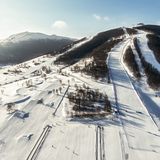 Ski China
Ski China
Having the world’s largest national population and plenty of the world’s highest mountains makes China, where skiing was virtually unknown less than 20 years ago, and which has by far the world’s fastest growing ski population, the fastest growing number of ski areas, and the country with the most potential growth market through the 21st century for winter sports anywhere in the world.
There is skiing right across the country however in 13 provinces and autonomous regions.
The greatest proportion are in the most northerly province of Heilongjiang, where the distinctly chilly regional capital, Harbin - known in China as the 'Ice City' and famous for its annual ice festival with spectacular ice carvings – staged the country's first ski forum in 2003, with guests and speakers pouring in from almost all the world's ski nations.
There are also a dozen or so small ski areas around capital Beijing and many other ski hills are located near to China’s other cities. These include some of the world’s largest indoor snow centres of which China now has six.
However destination resorts are beginning to develop too. Xiling Snow Mountain which opened in 2004 is now claiming to have taken the title of “Leading resort in China” from Yabuli and appears to offer the potential to grow in to a major international resort.
The resort has a gondola, double and quad chairs, currently serving ten trails for all standards and up to a kilometre long, but significantly the famous Xiling Snow Mountain extends to over 5300m above giving plenty of scope to create one of the world’s biggest lift served verticals.
Tourism professionals are keen to point out that two thirds of China’s 1.3 billion population live in mountainous areas, or than 700 million live within three hours of one of the new ski areas so are able to ski China.
Currently the Chinese ski market is variously estimated at between 1 and 10 million people (most commonly a figure of 3 million is quoted). As many as 15 million people have been 'made wealthy' out of China's 300 million urban dwellers in China.
The number of operational ski areas is uncertain and difficult for anyone to know for sure, including the Chinese. Again reports vary between wildly optimistic estimates of “50 opening each year with 500 by 2010,” to more conservative figures. At least 60 Chinese ski areas can be identified however.
The rapidly increasing numbers of Chinese skiers, most of whom are from the increasingly wealthy Chinese ‘middle-class’ coupled with the limited facilities in China to date for novice skiers to progress on to, has led to the most recent development of more substantial ski areas with greater challenges.
The country is now also home to the world’s two highest lifts, both gondolas, although only one serves a (small) ski area. Lift company Doppelmayr completed the world’s highest gondola in 2008 with eight passenger cabins which reaches 4,843m above sea level. The lift accesses The Aba Great Glacier in Sichuan province, about six hours driving time from regional capital Chengdu. The top station is 327m higher than the previous record holder, also in China, the Leitner built Jade Dragon Snow Mountain in Yunnan province, which has a top station height of 4,516m and has recently added two drag lifts to create a small ski area at the top, the world’s highest.
China: latest snow conditions round-up
Summary of forecast snowfall and ski conditions for resorts in China. Fresh snow is forecast at 0 resorts. Powder is reported at 0 resorts and 0 are reporting good piste conditions.
All resorts
Ski resorts of China, alphabetically
| Resort |
|
snow depth top and bottom |
on-piste |
off-piste |
Last Snow |
Next 9 Days 0–3 | 3–6 | 6–9 snow (cm) |
Freezing level (m) |
||||||||||||||||||||||||||||||
|---|---|---|---|---|---|---|---|---|---|---|---|---|---|---|---|---|---|---|---|---|---|---|---|---|---|---|---|---|---|---|---|---|---|---|---|---|---|
| Fri | Sat | Sun | Mon | Tue | Wed | Thu | |||||||||||||||||||||||||||||||
|
(69 m — 419 m) snow report 27 days ago |
|
|
|||||||||||||||||||||||||||||||||||
|
(610 m — 1219 m) snow report 17 days ago |
|
|
|||||||||||||||||||||||||||||||||||
|
(555 m — 1405 m) snow report 2 days ago |
|
|
|||||||||||||||||||||||||||||||||||
|
(1771 m — 2100 m) snow report 27 days ago |
|
|
|||||||||||||||||||||||||||||||||||
|
(1500 m — 2174 m) snow report 27 days ago |
|
|
|||||||||||||||||||||||||||||||||||
|
(255 m — 463 m) snow report 2 days ago |
|
|
|||||||||||||||||||||||||||||||||||
|
(300 m — 900 m) snow report 2 days ago |
|
|
|||||||||||||||||||||||||||||||||||
|
(1700 m — 2100 m) snow report 27 days ago |
|
|
|||||||||||||||||||||||||||||||||||
|
(1649 m — 2159 m) snow report 27 days ago |
|
|
|||||||||||||||||||||||||||||||||||
|
(450 m — 1206 m) snow report 2 days ago |
|
|
|||||||||||||||||||||||||||||||||||
|
(820 m — 1210 m) snow report yesterday |
|
|
|||||||||||||||||||||||||||||||||||
|
(1710 m — 2110 m) snow report 27 days ago |
|
|
|||||||||||||||||||||||||||||||||||
|
(998 m — 2097 m) snow report 17 days ago |
|
|
|||||||||||||||||||||||||||||||||||
|
(500 m — 1384 m) snow report today |
|
|
|||||||||||||||||||||||||||||||||||







